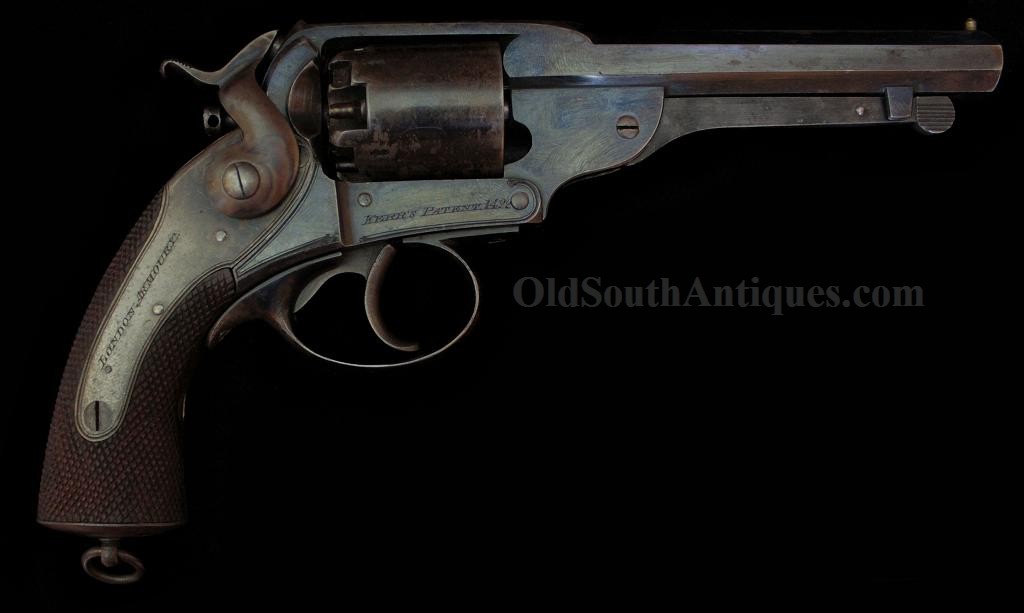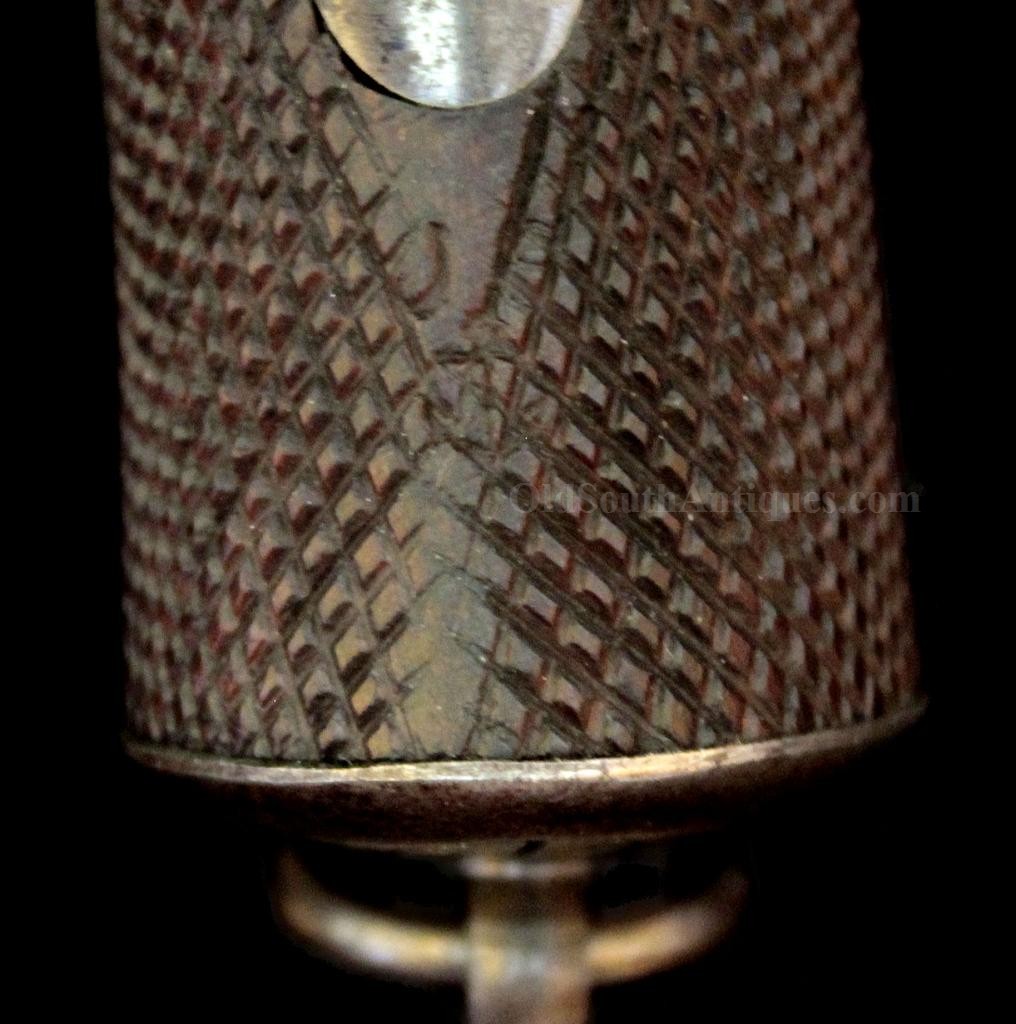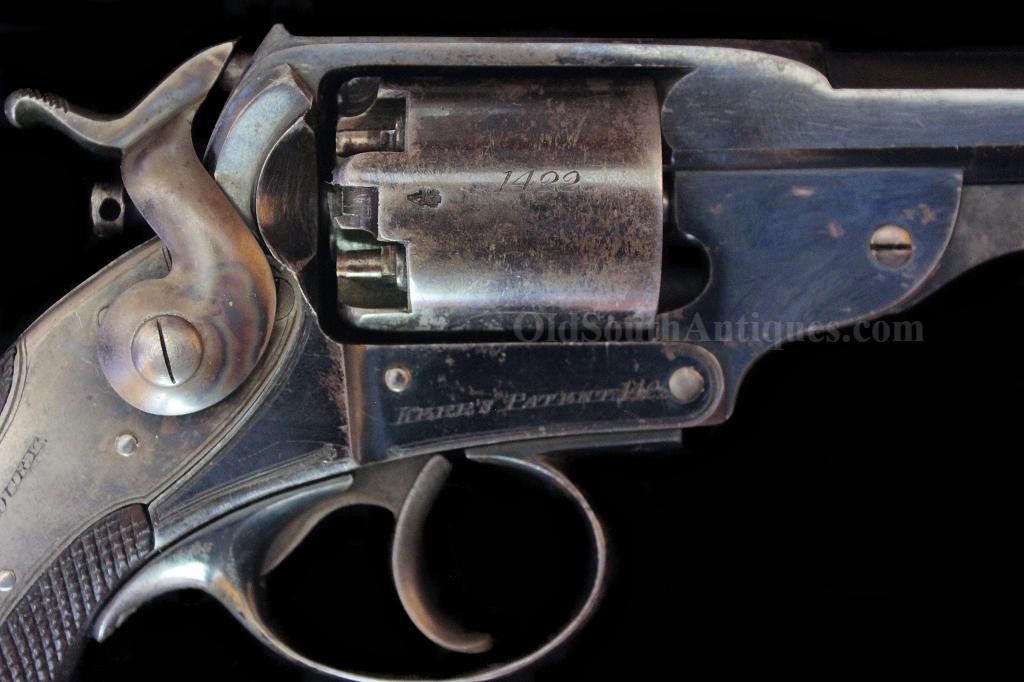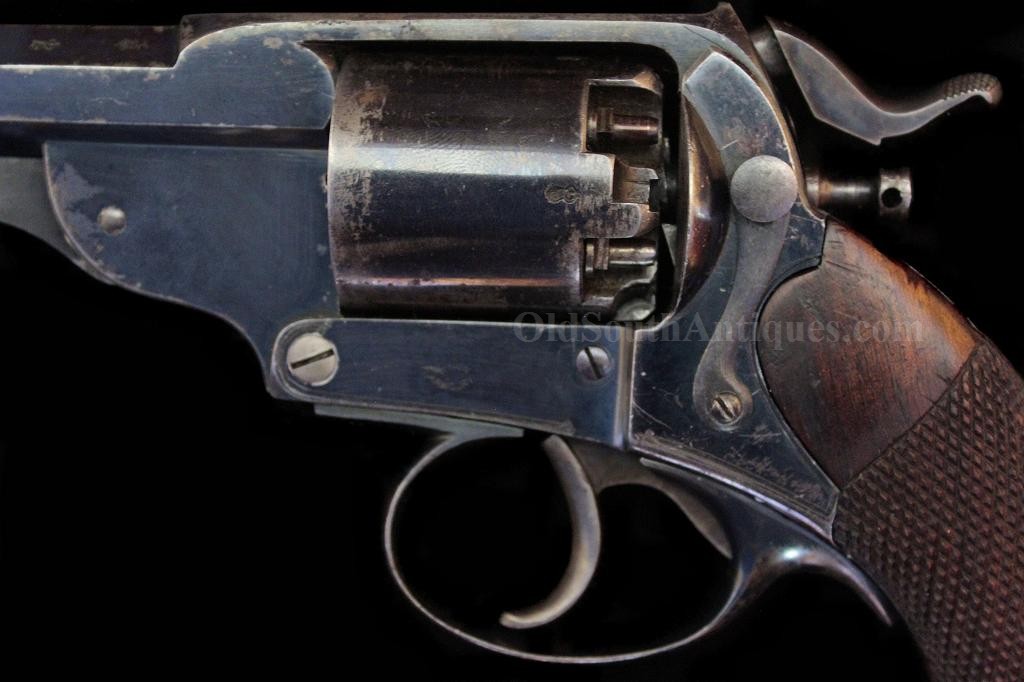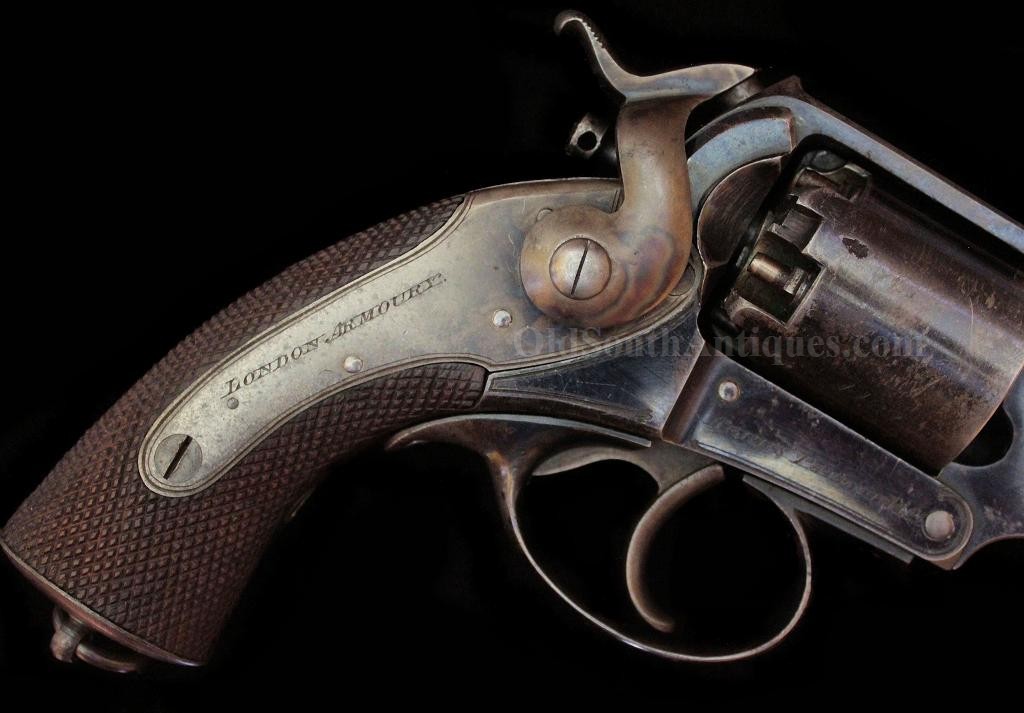
| Catalog | Past Items | Order Info | Terms/Conditions | About Us | Inventory Clearance |
Confederate purchasing agent Caleb Huse purchased approximately 7000 Kerr’s patent revolvers from the London Armoury during the War Between the States. Some but, not all, of these were stamped with the JS over an anchor like the one shown here. There are enough Confederate associated Enfield rifles and Kerr revolvers bearing this mark to say with certainty that all arms having this stamp are Confederate purchased weapons.
These revolvers were issued to Confederate cavalry in large numbers, including the 7th, 11th, 12th, 18th and 35th Virginia as well as the 24th Georgia and 8th Texas. However this revolver has never been fired.
This particular example is one of the early guns, serial number 1422, so it is unlikely that it was captured by the blockade, more likely an inspector or high ranking officer took it for himself. It has a JS over anchor stamping in the crisp checkered grip. The revolver is in excellent, original condition. The gun still retains 80-90% percent of its original blue and the original case colors on the lock and hammer. The rifling is sharp and bright. The action works perfectly. The checkering on the stocks is so sharp that it "bites” your hand when you grip it. The JS Anchor is extremely clear.
It has been many years since I have seen an example of a JS Anchor marked Kerr that equals this condition. Confederate marked imported arms are in high demand and though this is not mint new, it was little used and is among the very best in existence.
Flawless!
The research below was researched and written by Captain Steve Knott, author of The Confederate Enfield. It is conclusive evidence that the Confederate JS Anchor inspector mark was done by John Southgate. My thanks to Steve for allowing me to share this with you.
Introduction
Current consensus within the community of American Civil War arms historians and Confederate Enfield collectors asserts that the JS-Anchor inspector’s mark denotes London Armoury Company viewer James Smiles. This hypothesis was first presented by Wiley Sword in his groundbreaking book, Firepower From Abroad: The Confederate Enfield and the LeMat Revolver, and fully endorsed by authors Howard Madaus, James Whisker, Daniel Hartzler, and Larry Yantz in subsequent reference works addressing the subject of Confederate Enfields and related markings.[i] Sword’s findings were based on excerpts from Confederate Major Edward C. Anderson’s wartime diary and amplifying information provided by respected British arms historian DeWitt Bailey. Anderson’s diary includes a specific reference to a British government viewer named "Southgate” whom the Confederates employed to inspect the quality of contracted arms prior to final purchase and shipment. As described by Anderson, Southgate was engaged in secret work for the Confederates while ostensibly on sick leave from his official duties at the London Armoury Company. Given the potential censure should these activities be compromised – coupled with the inability of modern collectors and historians to find any other reference to Southgate in period records – Sword concluded that Southgate must be a fictitious name invented by Anderson to protect the actual identity of the viewer. In support of this conclusion, Bailey identified James Smiles as the likely candidate and confirmed his employment as a viewer at the London Armoury Company during the period specified (1861).[ii] Obviously, Smiles’ initials also correspond with the JS-Anchor mark. As noted above, this interpretation has been universally accepted by the leading researchers in the field and remains unchallenged to date.
Sword’s pseudonym theory appears cursory and unconvincing, however, when viewed within the context of Anderson’s entire diary. An examination of other sensitive entries in the diary will serve to illustrate this point clearly, making it quite apparent that Southgate was no pseudonym for Smiles. In addition, while Sword and other researchers have lamented the absence of any period information confirming the existence of Southgate, this assertion is simply not accurate in 2006; electronic access to public records now makes it possible to discover the identity of Southgate. Moreover, despite all that has been written concerning the possible identity of "JS”, adequate explanation concerning the significance of the anchor symbol has remained absent from all reference works to date. The anchor is an integral component and this omission constitutes an obvious shortfall in previous efforts to decipher the mark. A thorough discussion of the anchor and the symbol’s relevance is therefore warranted to remedy this discrepancy.
In summary, the information and analysis offered here will seek to dismiss James Smiles and the pseudonym hypothesis, reveal the identity of the correct "JS” viewer (Southgate), and provide an explanation of the significance of the anchor symbol. In so doing, an accurate and comprehensive understanding of JS-Anchor inspector’s mark should emerge.
Major Anderson and his Diary
Appointed personally by Confederate President Jefferson Davis and charged with acquiring artillery, arms, and equipment for the Southern war effort, Major Edward C. Anderson served as the senior army purchasing agent in Europe from 22 June 1861 until his return aboard the blockade runner Fingal four months later. Operating primarily from Liverpool, London, and Birmingham in Great Britain, Anderson and his capable assistant, Captain Caleb Huse, worked diligently to purchase quality weapons in sufficient quantity while cloaking the true nature of their activities from the attention of British government officials and Union agents. The cities most frequented are significant; Liverpool contained Anderson’s financial creditors (Fraser, Trenholm, and Company) and served as a convenient port facility, London was the site of quality weapons production and also housed the principal arms contractor serving the Confederates ((Sinclair, Hamilton, and Company), and Birmingham boasted the Gun Trade, the most prolific producer of military small arms in England.[iii] The European infantry weapon that best approximated the Federal Springfield rifle-musket in quality, performance, and reliability was the British Pattern 1853 rifle-musket and its rifle derivatives. Consequently, the Enfield was highly prized and sought after by Anderson and Huse.[iv]
Anderson’s diary begins with an introduction written during the voyage abroad and continues with frequent dated entries made through 13 March 1862. His wartime experiences following this date were recorded in "another memorandum book,” but this second diary has yet to be found.[v] Fortunately, Anderson’s account of his operations in Great Britain between late June and mid-October 1861 survive in the existing diary and remains the most significant source of information for unraveling the mystery of the JS-Anchor mark. Anderson specifically mentions gun viewers on four separate occasions in his diary; references are made to a viewer named "Southgate” on 2 and 5 August 1861, and to viewer "Hines” on 18 and 19 September 1861. For purposes of this investigation, only the entries relating to Southgate are germane:
"Fri 2d Aug. 1861. Liverpool. Wrote S. H. & Co (Sinclair, Hamilton, and Company) that Huse had agreed to receive 550 of Graysbrooks (arms dealer subcontracted by Sinclair, Hamilton, and Company) short Enfield Rifles & directed them to send down our ‘Viewer,’ prior to their being accepted. This term Viewer is equivalent to our ‘Inspector’ and in order to meet the frauds of the gun dealers I have arranged with Messrs S. H. & Co. to obtain the service of the Tower Viewer. To this end we have got him a sick leave of absence from the Govt & have put him to work for the Confeds….” [vi]
"Birmingham Mon. 5th Aug. 1861. Attending to business for the Confedy, inspecting arms with Mr. Southgate, viewer to the London Armory Company, who is operating in our interests. Left Birmingham at 2 pm and after a pleasant ride arrived in London at 6 pm….” [vii]
Key pieces of information can be gleaned from these entries. Anderson provides the name of the inspector, Southgate, and notes that he is a British government viewer assigned to the London Armoury Company (his duties being to inspect and approve firearms filling British military contracts). He also details the fact that Southgate is ostensibly on sick leave from his government job, and that his services and the subterfuge were arranged by Sinclair, Hamilton and Company. As Sword keenly observes in Firepower from Abroad, this was likely arranged by Archibald Hamilton. Hamilton, in addition to being a senior partner of Sinclair, Hamilton, and Company, was also director of the London Armoury Company and therefore well motivated and empowered to complete all facets of this arrangement.[viii] Lastly, but significantly, viewer Southgate is summoned to Birmingham to inspect the Enfields. As described by Anderson, this trip is only a four hour journey by train from London. All of this information will prove instrumental in identifying "JS” and also includes the crucial clue leading to the anchor symbol’s meaning.
As outlined in the introduction, Sword and other researchers believe Southgate is a pseudonym for James Smiles. Anderson’s diary, however, is clearly characterized by absolute candor, excessive factual detail (often to the point of superfluousness), and an obvious assumption of confidentiality. Anderson, for example, notes early on that Huse does not possess the confidence of President Davis and that he is fully authorized to relieve the captain of his duties should he judge Huse "treacherous or not trustworthy.”[ix] Moreover, extremely sensitive information – including Confederate state secrets – is described in detail with no apparent effort to protect it from compromise. No use of pseudonyms, abbreviations or code is evident in any diary entry to shield the identity of individuals, place-names, ships, or other vital information (though Anderson often abbreviated a name in subsequent sentences once the individual was introduced; e.g., "Mr. Huse” followed by "Mr. H.”). Three specific examples will well illustrate this point, demonstrating to the reader that Anderson made no attempt to protect information far more sensitive – and potentially damaging – than revealing the identity of a simple gun viewer.
First, in a lengthy diary entry made on 1 July 1861, Anderson discusses a covert financial contribution made by Edmund Molyneaux, British consul to Savannah, Georgia. Molyneaux, on leave in London at the time, personally secured a loan totaling £10,000.00 on the behalf of Anderson. This money allowed Anderson to acquire "a very superior lot of Enfield Rifles” (Barnett manufacture) ahead of a rival Federal purchasing agent. As was Anderson’s custom, the diary relates all aspects of this event in exceptional detail, including the name of the banker who conducted the transaction![x] Given Great Britain’s rigid policy of neutrality concerning the American war, Molyneaux – as a senior government official – risked censure and the likely forfeiture of his consul post should his actions be exposed. Anderson, however, makes no attempt to protect Molyneaux’s identity in his diary. An independent source, the 1859 Savannah City Directory, includes Edmund Molyneaux and confirms he is the British consul as described by Anderson.[xi] It therefore defies logic to assume that Anderson would provide a pseudonym for gun viewer Smiles and not afford Her Majesty’s Consul Molyneaux equal protection.
Second, Anderson’s diary includes extremely confidential information concerning the blockade runner Fingal. In an entry dated 11 September 1861 Anderson writes that he "… received a letter today announcing the purchase of the steamer Fingal for £17,500. The Fingal is a new vessel of about 800 tons English measurement & is represented to be one of the finest class of iron built ships….”[xii] The existence of Fingal and its mission constituted no less than a Confederate state secret; the ship ran the blockade in November 1861 with the largest single cargo of war materiel to be delivered during the conflict, including 15,000 Enfield rifles, 500 revolvers, 3,000 sabers, 1 million cartridges, 2 million percussion caps, four cannon, and 400 barrels of gunpowder.[xiii] Anderson notes in late September and again in early October that he is under surveillance by Federal agents, prompting his decision on 2 October 1861 to capture the enemy spy should he successfully trail Anderson to Fingal. In fact, on 10 October, Union agents are so active that Anderson details the necessity of hiding Fingal on the Mersey River near Liverpool and transferring ownership of the ship and its cargo to another party to avoid detection.[xiv] Perhaps the most telling evidence of the blockade runner’s significance to the Confederate war effort, however, is Anderson’s decision to relinquish his European duties to Huse and accompany Fingalon its transatlantic voyage to Savannah. Again, as in the Molyneaux example, it simply defies logic to assert that Anderson would provide a pseudonym to protect gun viewer Smiles and then blatantly reveal the purchase, mission, and location of Fingal in other diary entries.
Third, in an entry made on 5 October 1861, Anderson describes a clandestine meeting conducted with James D. Bullock, the senior Confederate navy purchasing agent in Europe, and his assistant, Andrew Low:
"Fri 5th. Wet and disagreeable. In the evening Bulloch called at my rooms, as also did Mr And Low. We held a secret conference. We wrote out a short dispatch for the Richmond Govt to be carried across by (Henry) Hotze (Confederate sympathizer and editor of the London Index). Added in a code of signals and sent Mr H (Hotze)off by the eleven ock train for London….” [xv]
This entry is remarkable given the sensitive information it discloses, and indicates without question that Anderson viewed his diary as completely confidential and safe from compromising eyes. In a subsequent entry made aboard Fingalon 12 November 1861, Anderson explains that the codes carried by Hotze provided the location the Fingal would run the blockade, as well as the secret recognition signals used to identify the ship to Confederate defenders upon arrival outside Savannah.[xvi] As such, the 5 October diary entry revealed obvious Confederate military secrets; had this information fallen into Union hands, the interception and capture of Fingal would have been easily accomplished by Federal naval forces. Consequently, as in the previous two examples, it simply defies logic to believe that Anderson would provide a pseudonym to protect gun viewer Smiles and then casually reveal the details of a secret meeting, including the identity of the participants and the courier conveying extremely confidential dispatches to Richmond!
The diary entries detailing Molyneaux, Fingal, and the "secret conference” should demonstrate clearly that Anderson would not employ a false name to shield the identity of James Smiles. The pseudonym theory simply does not pass muster when viewed against the absolute candor and transparency evident throughout Anderson’s record of events. Therefore, it is apparent that the viewer in question is indeed Southgate as specifically named by Anderson; to think otherwise is to dismiss the overall content and context of the diary.
Introducing John Southgate
Sword laments in Firepower from Abroad that despite "…extensive research and consultation with various knowledgeable collectors and historians in Europe, no information on Southgate has surfaced.”[xvii] Current electronic access to public records featuring convenient search options, however, now permits us to locate Southgate’s identity quite easily in the 1861 London Census data. There are only three individuals named Southgate listed in the census between the ages of 15 and 70 whose occupation is "gunsmith” or "gun maker”: Robert Southgate, Henry Southgate, and John Southgate. Robert was age 65, "head” of his household, listed as a "gunsmith”, and resided at 14 Bouveries Street in the Kensington borough of London. Henry was 16 years old, listed as "son” and "gunsmith”, and also resided at 14 Bouveries Street. Henry was obviously Robert’s son (or grandson) and pursuing the family trade. John Southgate was age 33, "head” of his household, listed as a "gun maker”, and lived at 53 St. Andrews Street in the Newington section of London.[xviii] Robert and Henry Southgate are likely too old and too young respectively to be employed as a government arms viewer at the London Armoury Company; moreover, their names do not correspond to the initials "JS”. John Southgate, however, was the proper age and his name is the only one that matches the "JS” mark. Additionally, given his Newington address, Southgate also lived near the London Armoury Company.
The London Armoury Company, founded in 1856, was located in the Bermondsey borough of south London.[xix] Bermondsey is adjacent and quite close to Newington (on the modern underground map, the closest Newington station is only one tube stop from Bermondsey).[xx] In the nineteenth century, the principal means of traveling to work was by foot or hansom cab.[xxi] As such, it is logical to assume that working class individuals chose to live as close as possible to their place of employment. John Southgate, residing in Newington, had only a short walk to reach the London Armoury Company, thereby providing further evidence that he is the same Southgate mentioned by Anderson in his diary. As a point of comparison, James Smiles lived at 17 Balaclava Road in Bermondsey and likewise had a short stroll to the London Armoury Company (he was age 37, "head” of household, and listed as a "gunsmith”).[xxii]
Two other factors regarding John Southgate are also germane. In 1861, Southgate had over ten years of experience in the gun trade (he is listed in the 1851 London Census as a "gun maker” at age 23).[xxiii] Occupational experience would certainly be a prerequisite for employment with the government as a gun viewer; therefore, Southgate was well qualified to be an arms inspector. Additionally, Southgate was supporting a wife (Mary, 35) and five children between the ages of one and twelve (Thomas, 1; James, 5; Kate, 7; Mary Ann, 10; George, 12). Consequently, the lure of higher wages working for Anderson may have enticed Southgate to accept the risk of losing his government job should the "sick leave” charade fail and his illegal work for the Confederates be exposed. In contrast, James Smiles had only one young daughter (Herte, 4) to look after in 1861 (no wife is present in the census data); as such, Smiles did not possess the same financial challenges as did his colleague John Southgate.[xxiv]
In summary, all evidence supports the case for John Southgate. He is specifically identified by Anderson in his diary; he is one of only three individuals named Southgate listed in the 1861 London Census employed in the gun trade; he is the only one whose name corresponds to the initials "JS”; he was the proper age and possessed the requisite experience to be employed as a government arms inspector; he lived within walking distance of the London Armoury Company; he had a large family to support and was likely seeking extra income. Consequently, given the preponderance of these facts, there remains virtually no doubt that John Southgate was the Confederate viewer in question.
Birmingham’s Anchor
Why did John Southgate choose to add an anchor symbol to his viewer’s mark? Though no researcher has attempted to answer this query to date, the key clue can be found in the diary entry of 5 August 1861 in which Anderson notes that he and Southgate are inspecting arms in Birmingham. The location is significant because the anchor symbol enjoys an enduring association with Birmingham – and actually served as the city’s unofficial logo during the nineteenth century. The popularity of the nautical symbol with period Birmingham residents is well demonstrated by the abundance of town pubs named "The Anchor” in vogue during the 1800s (only one of which survives in 2006).[xxv] The original and official role of the anchor symbol, however, was as a quality control hallmark in the silver industry. Birmingham has long been a leading center of the silversmith trade, as evidenced by the establishment of the Birmingham Assay Office by Act of Parliament in 1773. Assigned the anchor symbol as its royal hallmark, the office was among the first two sites authorized to conduct testing and appraisal of precious metals independent of London. In fact, the anchor still serves as the official logo for the Birmingham Assay Office. [xxvi]

The design of the anchor as it appears in the assay seal clearly resembles that used by Southgate in the JS-Anchor mark, and this similarity is likely no coincidence. The exceptional reputation of Birmingham’s silver industry was well known throughout Europe; therefore, by association, the anchor hallmark was a recognized symbol of high quality and superior workmanship. Consequently, it appears that Southgate "borrowed” the symbol to serve as a quality control mark for his own inspection purposes.
The choice of the anchor symbol was certainly appropriate as the vast majority of Southgate’s work entailed inspecting guns manufactured in Birmingham. The Birmingham Gun Trade out-produced the London manufacturers by a factor of well over two-to-one during the war years. Between 1861 and 1864, the Birmingham makers turned out 783,403 arms for the export military market; all but approximately 50,000 of these weapons were supplied to the two American belligerents. In contrast, the London makers produced 344,802 guns for the American market during the same period.[xxvii] Given this demand, coupled with the relative ease of traveling to Birmingham from London (four hours by train as noted in Anderson’s diary), it is logical to assume that most – if not all – of Southgate’s inspection work was performed in Birmingham. The arms produced in London were likely consolidated and shipped in company with the larger Birmingham lots. As such, it is also logical to surmise that any weapon made in London bearing a JS-Anchor viewer’s mark was actually inspected in Birmingham.
Finally, there is a secondary motive for Southgate to adopt a well recognized Birmingham symbol as his personal mark; the anchor served to disguise his true identity as a government viewer normally employed in London. Southgate certainly risked dismissal from his government post if found out, so he would endeavor to take every precaution to avoid compromise. Therefore, it is extremely doubtful that Southgate would risk using the JS-Anchor mark at the London Armoury Company (or any other location where he was well known). Those guns manufactured at the London Armoury Company bearing the JS-Anchor were likely inspected and marked by Southgate in Birmingham as part of an assorted lot of arms, his official connection to the company being only coincidental in this case and unrelated to his work as a Confederate viewer.
The significance of the anchor has long eluded arms historians and collectors of Confederate Enfields. As demonstrated, the answer to this mystery is straightforward when viewed against the backdrop of Birmingham. Southgate, working in Birmingham, shrewdly selected a well-recognized city symbol and respected silver industry hallmark as his own quality control mark. In so doing, the anchor symbol also served as a clever deception tool to conceal his actual affiliation with the London Armoury Company and the British government. Southgate must have been satisfied with the choice; surviving JS-Anchor marked firearms dated 1861 through 1864 reveal that he retained the anchor symbol throughout his tenure as a Confederate viewer.[xxviii]
Conclusion
This concise study of the JS-Anchor viewer’s mark has attempted to correct prevailing assumptions regarding the identity of the Confederate inspector, as well as furnish the collector and historian alike with amplifying information regarding the origin of the design. As shown, a comprehensive analysis of Anderson’s diary clearly undermines the Southgate pseudonym theory and dismisses James Smiles as the identity of the viewer. Likewise, the diary entries – coupled with 1851 and 1861 London Census data – provide the evidence required to identify the actual inspector as John Southgate. Lastly, the significance of the anchor as a symbol of Birmingham has also been revealed, thereby ensuring all facets of this enigmatic mark have been properly explored.
Why is it important to set the record straight concerning the JS-Anchor mark? Regrettably, the role of the British Enfield as the workhorse of the Confederate army has been largely underappreciated in Southern historiography and among the collecting community. Instead, domestically manufactured Confederate small arms – such as those made at Richmond or Fayetteville – garner the lion’s share of interest and attention despite the paucity of these weapons on the actual firing line. This is due in part because the vast majority of Confederate Enfields are devoid of discrete markings and therefore remain anonymous. Nevertheless, this circumstance does not alter the fact that there were over ten Enfield guns in Confederate service for every one Richmond arm on the field (and Richmond was the most prolific Southern maker having produced approximately 31,000 rifle-muskets during the war).[xxix] The JS-Anchor, as the most prevalent Confederate inspection mark, fortunately permits us to identify those few distinguishable survivors of a once abundant supply of Enfield arms whose legacy is inexorably linked with that of the soldiers who carried them into battle at Gaines Mill, Second Manassas, Sharpsburg, Fredericksburg, Chancellorsville, Gettysburg, and many other contested fields. Simply, it is because of this enduring legacy that John Southgate deserves to be recognized; his efforts were instrumental in ensuring that thousands of quality Enfields reached the hands of the finest light infantry this nation has as ever produced. And this marriage of necessity – uniting rebel and rifle in the face of overwhelming odds – resulted in battlefield achievements unrivaled in American military history.
[i] Wiley Sword, Firepower from Abroad: The Confederate Enfield and the LeMat Revolver(Lincoln, RI: Andrew Mowbray, Inc., 1986), 121-124. Howard M. Madaus, "’This Butts for You!’ The Significance of Marks and Engravings Found on the Butts of Confederate Enfield Rifles and Rifle-Muskets” (unpublished paper). James B. Whisker, Daniel D. Hartzler, and Larry W. Yantz, Firearms from Europe, Second Edition (State College, PA: Tom Rowe Books, 2002), 27-28.
[ii] Sword, 121-122.
[iii] W. Stanley Hoole, ed., Confederate Foreign Agent: The European Diary of Major Edward C. Anderson (University, AL: Confederate Publishing Company, 1976), 1-5. Samuel B. Thompson, Confederate Purchasing Operations Abroad (Gloucester, MA: Peter Smith, 1973), 7-17. John D. Goodman, "The Birmingham Gun Trade,” in Birmingham and the Midland Hardware District, ed. Samuel Timmins (London: Frank Cass & Co., Ltd., 1967), 417-418.
[iv] Caleb Huse, The Supplies for the Confederate Army: How They were Obtained in Europe and How Paid For (Boston: T. R. Marvin & Son, 1904), 20. Hoole, 24.
[v] Hoole, 120.
[vi] Ibid., 39, 139.
[vii] Ibid., 43.
[viii] Sword, 122.
[ix] Hoole, 17.
[x] Ibid., 23-26.
[xi] Paula Franklin, "1859 Savannah City Directory” (accessed 18 April 2006); available from http://www.rootsweb.com/~gachath2/1859SavCityDir.html; Internet.
[xii] Hoole, 55.
[xiii] Ibid., 5.
[xiv] Ibid., 63-64, 68-70,
[xv] Ibid., 71, 142.
[xvi] Ibid., 93.
[xvii] Sword, 122.
[xviii] "London 1861 Census Transcript” (accessed 7 April 2006); available from S & N Genealogy at http://www.thegenealogist.co.uk/index.php; Internet.
[xix] "The London Armoury Company” (accessed 10 April 2006); available from Wikipedia at http://en.wikipedia.org/wiki/London_Armoury_Company; Internet.
[xx] "Bermondsey” (accessed 10 April 2006); available from Wikipedia at http://en.wikipedia.org/wiki/Bermondsey; Internet.
[xxi] David Williams,The Birmingham Gun Trade (Stroud, Gloucestershire: Tempus Publishing Ltd., 2004), 48.
[xxii] "London 1861 Census Transcript.”
[xxiii] "London 1851 Census Transcript” (accessed 12 April 2006); available from S & N Genealogy at http://www.thegenealogist.co.uk/index.php; Internet.
[xxiv] "London 1861 Census Transcript.”
[xxv] Kieron McMahon, "History of the Anchor Inn” (accessed 16 April 2006); available from http://www.the-anchor-inn.fsnet.co.uk/history.htm; Internet.
[xxvi] "The Birmingham Assay Office” (accessed 16 April 2006); available from http://domain751573.sites.fasthosts.com/assayoffice/index.html; Internet.
[xxvii] Goodman, 418.
[xxviii] Madaus.
[xxix] Paul J. Davies,C. S. Armory Richmond (Carlisle, PA: by the author, 2000), 349.
Copyright © 2025 OldSouthAntiques.com All Rights Reserved.
Privacy Policy | Terms of Use
Powered by Web-Cat Copyright © 1996-2025 GrayCat Systems
